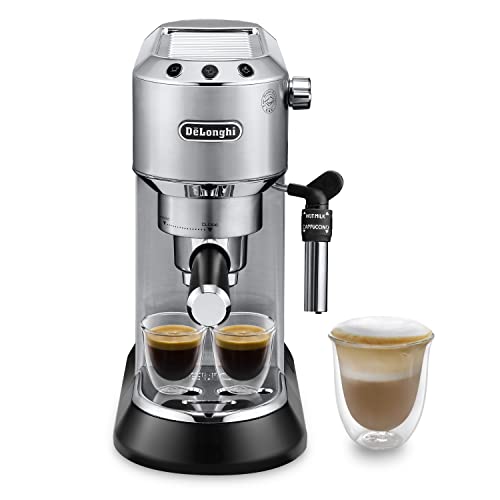How to Make Espresso Machine Coffee
Espresso machines can create an amazing cup of coffee, however they require more care and setup than a typical coffee maker. You'll also need to grind and tamp the beans by yourself.
The most important ingredient in making espresso is pressure. The way an espresso machine operates is that a heating vessel heats the water to a perfect temperature, and then pushes it out of the spouts and through the grounds.
Temperature
Espresso is produced by forcing hot water under pressure through finely ground coffee beans. The temperature of the water is vital to the quality of the final shot. Insufficient temperatures cause absence of flavor compounds. High temperatures cause over extraction, which can cause a bitter or burnt taste.
The ideal temperature for espresso is between 195 and 205degF. This temperature can be achieved by using a grouphead that is designed to maintain an even temperature and stability throughout the process of brewing. The E61 is the most well-known group head, as it provides temperature stability, pre-infusion capabilities, and lever control.
When adjusting the espresso machine for different roasts and brew ratios it is crucial to take into consideration the impact of temperature on extraction yield and crema. The ideal temperature will vary on the specific bean and roast however the general rule is that lighter roasts and greater ratios of brew require higher temperatures than darker roasts and lower brew ratios. A high-quality thermocouple is essential for maintaining an even temperature.
Pressure
When brewing espresso machine coffee is pushed under pressure through finely ground coffee grounds that have been stamped. This causes chemical reactions to extract flavors, oils, and other soluble ingredients. The beverage that is made is usually richer and more flavorful.
The ideal espresso machine pressure is nine bar of pressure, which is equivalent to the atmospheric pressure at sea level. This is due to the fact that it's at this pressure that the soluble compounds in espresso beans are the easiest to extract.
However some espresso machines advertise 15 or 20 bars of pressure. While these machines may reach these levels of pressure however, they may not be in a position to maintain that level of pressure throughout the extraction.

One bar of pressure equals to 32 pounds per square inch (PSI) of the tire of a car. It's also four times the amount of pressure a professional cyclist uses when filling their bike tires. The ability to control the espresso machine pressure and create consistent espressos is essential for any serious barista at home.
Water
Water is an essential component in a delicious cup of espresso. The right water allows your beans to extract their full potential. However the wrong water can cause problems such as clogged pipes or even damage to your expensive machine.
The best choice is a natural spring water that is rich in minerals to ensure optimum espresso extraction. here are the findings will enhance the flavor of your espresso without the chalky mineral traces that are found from tap water or bottled water. This is an excellent alternative to distilled water or reverse osmosis. This process can be too purified and cause flavor problems.
It is not recommended to utilize a water filtration device that removes too much mineral content from your tap water. This can result in flavor and extraction issues. The best option is to buy an instrument for testing water, which will reveal the average hardness of your water in your area. This can be used to find a filtration system that will provide you with the right specifications for the water in your espresso machine.
Beans
The majority of coffee lovers become very involved in the whole process of making espresso. They are obsessed with a variety of variables, including temperature, pressure of water beans, milk viscosity and other factors. If one factor is slightly off, the entire shot may taste bad.
The most important factor in the matter of espresso is the beans used. Many people believe that only certain kinds are suitable for espresso. While some beans are better than others for specific purposes however, any bean that has been roasted can be used for espresso. Espresso beans are roasted longer than regular coffee beans, which is beyond the second crack. This makes them appear darker and makes them more water-soluble.
The best beans for espresso are typically medium roasted or dark roasted, which give the espressos their distinctive richness and boldness. However, it's possible to make great espresso with light roasted beans, particularly when the beans are pre-ground (for convenience in an espresso machine).
Milk
Espresso and milk is a classic combination. The combination of espresso and milk is an iconic. Not only does it increase energy levels, but it also balances the bitterness of espresso. There aren't many culinary pairings more perfect than this one!
If you choose to buy an espresso machine that is able to make cappuccino or latte make sure you consider how easy it is to use. Many of the best espresso machines have the jug which can be filled with hot or cold milk along with a steam wand as well as portafilters for pulling the shot. Some models also come with a built-in grinder along with a tamper, frother and tamper.
To get rid of any condensed water the steam wand needs to be purged each day before use (or after every cup of espresso). This process will take only 30 seconds, yet it is crucial to ensure that your machine is running smoothly. If you don't purge it, it could result in bitter taste and/or buildup of bacteria which can alter the taste or smell of your beverage. It's not difficult to do and should be a part of your regular maintenance routine.
